Standard [CURRENT]
ASTM E 272:2021
Standard Reference Radiographs for High-Strength Copper-Base and Nickel-Copper Alloy Castings
- German title
- Bezugsdurchstrahlungsbilder von Gußstücken aus hochfesten Legierungen auf Kupferbasis und Nickel-Kupfer-Legierungen
- Publication date
- 2021
- Original language
- English
- Pages
- 5
- Publication date
- 2021
- Original language
- English
- Pages
- 5
- DOI
- https://dx.doi.org/10.1520/E0272-21
Product information on this site:
Quick delivery via download or delivery service
Buy securely with a credit card or pay upon receipt of invoice
All transactions are encrypted
Short description
1.1 These reference radiographs illustrate various categories, types, and severity levels of discontinuities occurring in high-strength copper-base, nickel-copper, and related alloy castings. The reference radiograph films are an adjunct to this document and must be purchased separately from ASTM International, if needed (see 2.3 ). Categories and severity levels for each discontinuity type represented by these reference radiographs are described in 1.2 . Note 1: The basis of application for these reference radiographs requires a prior purchaser supplier agreement of radiographic examination attributes and classification criterion described in Sections 4 , 7 , 8 , 9 , and 10 of this standard. 1.2 These reference radiographs consist of forty-five 5 by 7 in. (127 by 178 mm) nominal size reproductions (20 made from 1 in. (25.4 mm) plate castings exposed with low voltage X-rays for thicknesses up to and including 2 in.) and 25 made from 3 in. (76 mm) plate castings exposed with 2 MV X-rays or Cobalt 60 isotope for thicknesses greater than 2 in. up to and including 6 in. Unless otherwise specified in a purchaser supplier agreement (see 1.1 ), each discontinuity category is for comparison only with production radiographs produced with radiation energy levels within the thickness range covered by the category. These reference radiographs illustrate discontinuities in sand-cast manganese-nickel-aluminum bronze-alloy plates and are representative of those found in narrow freezing range (formerly "high shrinkage"), high-strength copper and nickel-copper alloys. Following is a list of discontinuity categories, types, and severity levels for the adjunct reference radiographs of this standard (see Note 2 ): 1.2.1 Category A- Gas porosity; severity levels 1 through 5 for two thickness ranges. 1.2.1.1 A X - Up to and including 2 in. (50.8 mm) (called "Code A Discontinuity type" in previous revisions). 1.2.1.2 A G - Greater than 2 in. (50.8 mm) up to and including 6 in. (152.4 mm) (called "Code A Discontinuity type" in previous revisions). 1.2.2 Category B- Inclusions. 1.2.2.1 Ba- Sand inclusions, severity levels 1 through 5 for two thickness ranges. (1) BaX -Up to and including 2 in. (50.8 mm) (called "Code Ba Discontinuity type" in previous revisions). (2) BaG -Greater than 2 in. (50.8 mm) up to and including 6 in. (152.4 mm) (called "Code Ba Discontinuity type" in previous revisions). 1.2.2.2 Bb-Dross inclusions, severity levels 1 through 5 for two thickness ranges. (1) Bb X -Up to and including 2 in. (50.8 mm) (called "Code Bb Discontinuity type" in previous revisions). (2) Bb G -greater than 2 in. (50.8 mm) up to and including 6 in. (152.4 mm) (called "Code Bb Discontinuity type" in previous revisions). 1.2.3 Category C- Shrinkage; three types 1.2.3.1 Ca- linear shrinkage, severity levels 1 through 5 for thicknesses 2 in. up to and including 6 in. (50.8 to 152.4 mm). 1.2.3.2 Cb- feathery shrinkage, severity levels 1 through 5 for thicknesses up to and including 2 in. (50.8 mm). (Called "Cd feathery shrinkage" in previous revisions.) 1.2.3.3 Cc- spongy shrinkage, severity levels 1 through 5 for thicknesses 2 in. up to and including 6 in. (50.8 to 152.4 mm) (called "Cd spongy shrinkage" in previous revisions). Note 2: Discontinuity classes designated with a subscript "X" were produced with low energy X-ray radiation; discontinuity classes designated with subscript "G" were produced with Cobalt 60 or 2 MV X-rays, or both, and are the same reference radiographs and thickness ranges used in previous editions of this standard. Section 4 details the significance and use of these reference radiographs. 1.3 From time to time, there may be minor changes to the process for manufacturing of the reference radiograph adjunct materials. These changes could include changes in the films or processing chemicals used, changes in the dies or printing for the cardboard mats, etc.; however, in all cases, these changes are reviewed by the Illustration Monitoring Subcommittee and all reference radiographs are reviewed against a fixed prototype image to ensure that there are no changes to the acceptance level represented by the reference radiographs. Therefore, the adjunct reference radiographs remain valid for use with this standard regardless of the date of production or the revision level of the text standard. 1.4 Units- The values stated in inch-pound units are to be regarded as standard. The values given in parentheses are mathematical conversions to SI units that are provided for information only and are not considered standard. 1.5 This standard does not purport to address all of the safety concerns, if any, associated with its use. It is the responsibility of the user of this standard to establish appropriate safety, health, and environmental practices and determine the applicability of regulatory limitations prior to use. 1.6 This international standard was developed in accordance with internationally recognized principles on standardization established in the Decision on Principles for the Development of International Standards, Guides and Recommendations issued by the World Trade Organization Technical Barriers to Trade (TBT) Committee.
ICS
77.040.20,
77.150.30,
77.150.40
DOI
https://dx.doi.org/10.1520/E0272-21
Replacement amendments
This document has been modified by: ASTM RRE0272:1975
Also available in
Loading recommended items...
Loading recommended items...
Loading recommended items...
Loading recommended items...

